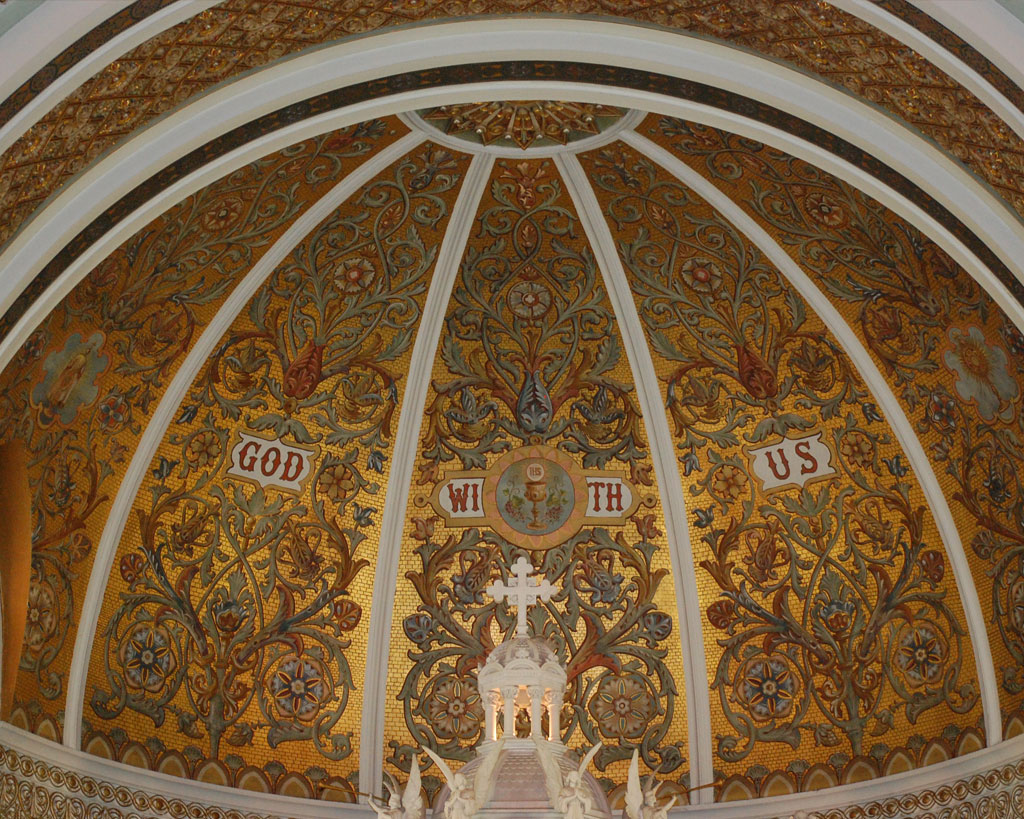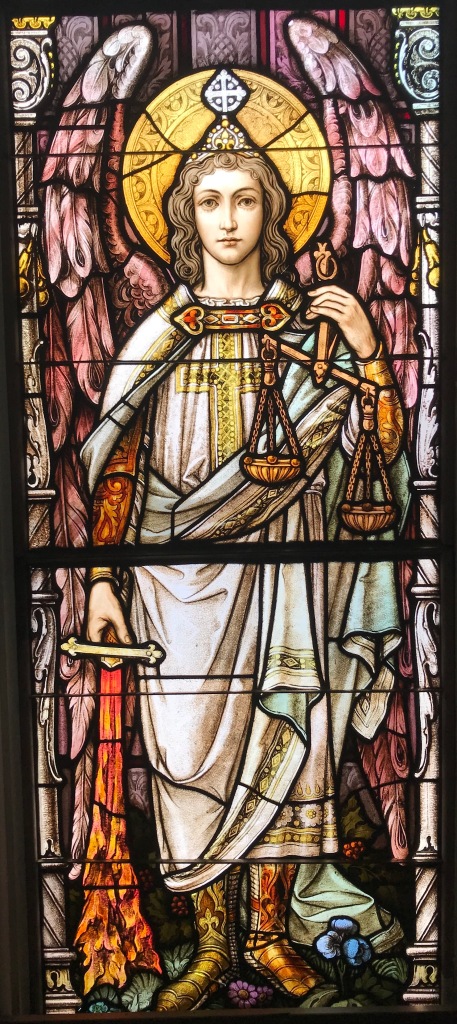The nave, or central hall, of the St. Joseph Church building is lined with ornamental columns called pilasters. What are the origins of these decorations, and what might they mean?
Trinity Window: the short story
An informal talk on the upper roundel of the south transept window:
So Many Goodbyes: the windows at St. Margaret Mercy
Today we celebrated what will likely be the last Mass in the chapel at Franciscan Health Hammond. The hospital, just south of St. Joseph, is downsizing, and much of the building will be torn down. It is a painful transition for all of us whose lives have been entwined with the institution for many years. I snapped quick photos of the stained glass windows, which, like the windows at St. Joe’s, were crafted in Germany, probably about a century ago. These windows show the same artistry in brushwork — paint layered onto the glass to create detail — and in composition: lifelike figures in dynamic poses; 3-D perspective; Romanesque architectural elements in the background.
I especially like this window, showing Franciscan saints gathered beneath Mary with the child Jesus…

…On the lower left is St. Bonaventure, one of the Church’s greatest theologians. The red hat at his knees shows that he was also a cardinal. He was a contemporary of Thomas Aquinas in the 1200’s, studied at the same university in Paris. He is the equal of Thomas in the scope and coherence of his theological synthesis. It may be fair to say that he surpasses Thomas in the literary quality of his work. He is less well known, however, perhaps because he left brick-and-mortar academia in the middle of his career to become the leader of the young Franciscan order. He steered the community through stressful times, overseeing its growth into an enduring institution. Six hundred years later, the global Franciscan community brought us St. Margaret hospital.

The two remaining large windows show Jesus healing the many people who flocked to him during his earthly ministry…

…and the Ascension…

…and here is a smaller window depicting the birth of Jesus.

9-11 Remembrance
Hammond firefighters, parishioners, and community members gathered today to remember 9-11 with prayer. We solemnly rang our 19th-century bells at 8:46 am, the clock time when the first aircraft struck the World Trade Center. The bells seemed to me to toll the words of Pope Paul VI to the United Nations in 1965: No more war; war never again.

The Sacred Heart Window

In this window, we see St. Margaret Mary Alacoque gazing at a vision of Jesus, who radiates golden light and gestures toward his sacred heart. In the foreground, the saint’s simple cloak trails on a red tiled floor. A graceful blue pitcher holds a lily. The lines of the saint’s grey habit draw the eye to her face, a delicate profile gazing upward in quiet gladness, just beneath Jesus’ outstretched hand. Jesus’ feet are bare, and are juxtaposed with her hands, almost touching, but not quite. Jesus seems to be standing on an altar, flanked by two tall candles.
His clothes are richly embroidered with cross and floral patterns, both his white robe and his bright red cloak, cascading in folds from the crook of his arm. The lines of the folds, and of the rays of light that emanate from him, point toward the image of his heart, glowing and encircled by thorns.
His face has the coloring and features of a central European, not historically accurate, but reflecting the context of the early 20th century Munich artists who created the glass. He bends his head toward Margaret, his eyes lowered, his expression faintly sad. Behind a blue curtain in the background, past two Corinthian columns and Romanesque archways, we catch a glimpse of trees and open sky, adding depth and a sense of space to the composition, the natural light of day contrasting with the unearthly light issuing from Jesus.
St. Margaret Mary Alacoque lived in France in the 1600’s. According to legend, she became very sick as a young teen, but recovered after promising to Mary, our blessed Mother, that she would enter religious life. As a religious sister, she experienced ecstatic visions of Jesus crucified appearing and speaking to her, encouraging devotion to his Sacred Heart.
This devotion, which had already been around for several centuries, spread and became even more popular, observed on first Fridays and especially on the Friday after Corpus Christi. Pope Pius VI defended the devotion against critics in the statement “Auctōrem fideī” in 1794.
St. Margaret Mary was canonized — officially recognized as a saint — in 1920, around the time our windows were crafted. St. Margaret’s visions included 12 promises from Jesus, including this one: “I will bless every place where an image of my heart is exposed and honored.”
This window dwells in the sanctuary, facing southwest, to the left of the altars. The position represents the place of the feast of the Sacred Heart in the liturgical year, as well as our place as believers in salvation history. The large windows in the nave tell a story, beginning with the Triune God in eternity, the south transept window, continuing with the Wedding of Mary and Joseph, and continuing counterclockwise around the building with the infancy narratives, the Christmas stories which we read during Advent and the Christmas season. Then come scenes of Jesus as a youth and an adult, working miracles and teaching, which we focus on during ordinary time. The story culminates with Eastertide and the feast of the Ascension in late Spring. These windows outline the whole mystery of Christ, accompanied by his teachings in the roundels at the top, which portray parables, or moral stories, from the Gospels. Continuing to follow this counterclockwise circuit of the building, the Melchizedek window comes next, associated with the feast of Corpus Christi. Then comes our window of the Sacred Heart, just as the feast of the Sacred Heart follows Corpus Christi in late Spring or early Summer. The exact dates of both feasts depend on the Easter season, which in turn depends on the cycles of the sun and moon, and changes each year. So we see how the building itself is a kind of calendar, tracing the seasons and the sacred year. Although St. Margaret Mary is a specific person, she could be viewed as symbolizing all of us. The great events of the Paschal mystery are in our past, but the story continues, and we are part of it, as we each encounter Jesus personally and strive to follow his teachings in our everyday lives.
St. Bonaventure, writing in the 1200’s, meditated on the meaning of the Sacred Heart in his treatise, “The Mystical Vine.” He describes Jesus’ heart as a temple, a holy of holies, which we, through prayer and grace, can enter, so that our heart becomes one with the heart of Christ in an intimate union: “To this temple, to this holy of holies, to this ark of the covenant, I will come to adore and to praise the Lord’s name, saying with David, ‘I have found my heart, that I may pray this prayer to thee.’ (2 Kings 7:27). But the heart I have found is the heart of my King and Lord, of my Brother and Friend, the most loving Jesus; then shall I not pray? Yes, I will pray, for I say without hesitation that His heart is also mine…Oh what a blessed lot is mine to have one heart with Jesus! But no marvel, this, since ‘the multitude of believers were of one heart.’ (Acts 4:32). Having found this heart, both yours and mine…I will pray to You, my God…draw my whole being within your heart…that I may come to You,…and be made worthy of living in Your heart all the days of my life (Ps 50), both knowing and doing Your will.” (III.4, Bougerol translation, 1960, p.154)
There is much more that could be said about the imagery in this window and about the topic of the Sacred Heart. I welcome feedback and more thoughts! Please post, or reach us through the contact form at SaintJosephHammondHeritage.com.
“I am the vine; you are the branches.”

In today’s Gospel, Jesus urges us to remain “in him,” united to him like branches to a vine. The vibrant fresco in the sanctuary reminds us of this teaching: five vine-like trees grow up the walls, curving and intertwining, bearing leaves, flowers, and the motto, “God with us.” A glowing gold background makes the colors seem to float away from the wall. You can lose yourself in the decoration, allowing the gaze to follow the curves and to rest on the symbols. The building contains other vine-like decorations as well, such as on the walls that flank the sanctuary and in the stained glass.
This art, along with the arch fresco and the Gospel writers, is most likely the work of John A. Mallin, who decorated hundreds of buildings in the Chicago area in the mid-20th century. The style imitates art found in illuminated manuscripts of the late Middle Ages, such as this one from the 1400’s: a curving vine grows up the margin of the page, partially crossing the gold background of a capital letter. A “Google image” search on “illuminated manuscripts” will turn up many more examples.

As Father Mens reminded us in his homily, remaining one with Jesus and his teachings in all we do is the heart of the Christian life, as we pass through daily decisions and struggles. Contemplating this fresco, each time we come to worship, can help us to remember.
Prayer to St. Joseph
A series of short videos pairing a 17th century poem with our stained-glass windows.
The Rich Man and Lazarus
A short video meditation with a Latin stanza from the Canticle of Mary.
The Arch Fresco
Commissioned in the 1930’s and completed in the 1940’s, this fresco is unique! It portrays the design and construction of our building, with leaders from our history, and it celebrates the Region’s industrial heritage. https://johnamallin.com/project/st-joseph-church/
Saints in the towers
Some of the most exquisitely detailed windows are found in the north and south towers, depicting saints. Up close, you can see the artists’s brushwork. These pieces are as much paintings as they are glass.


